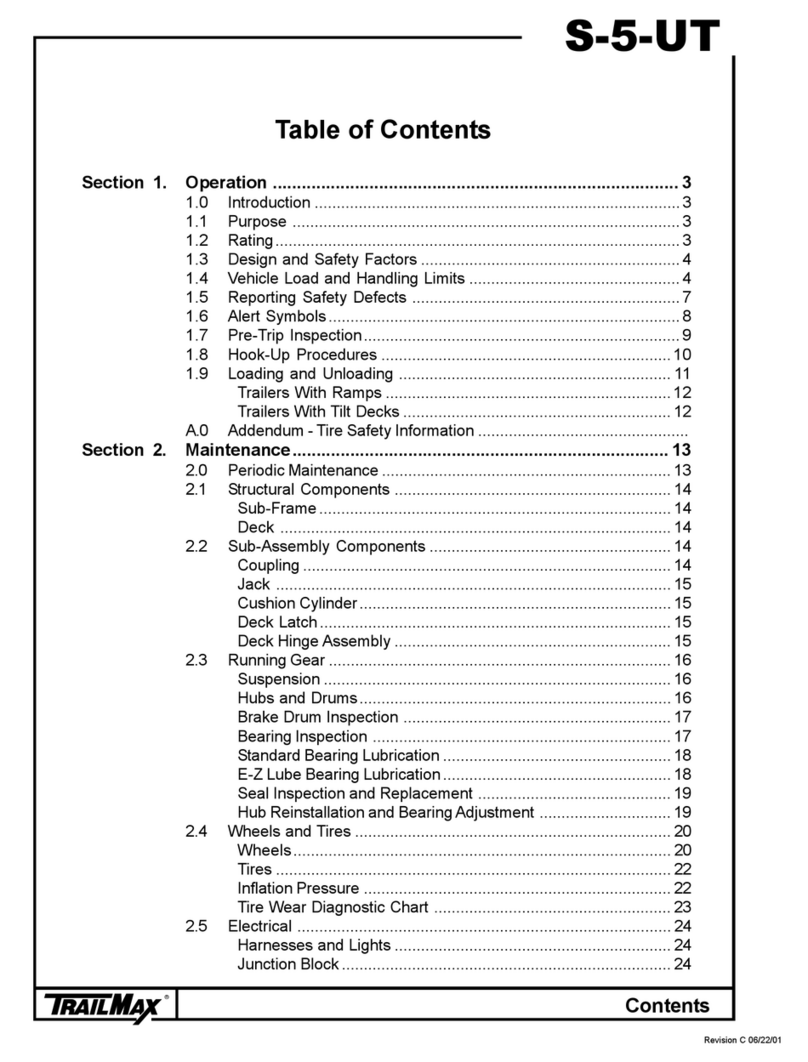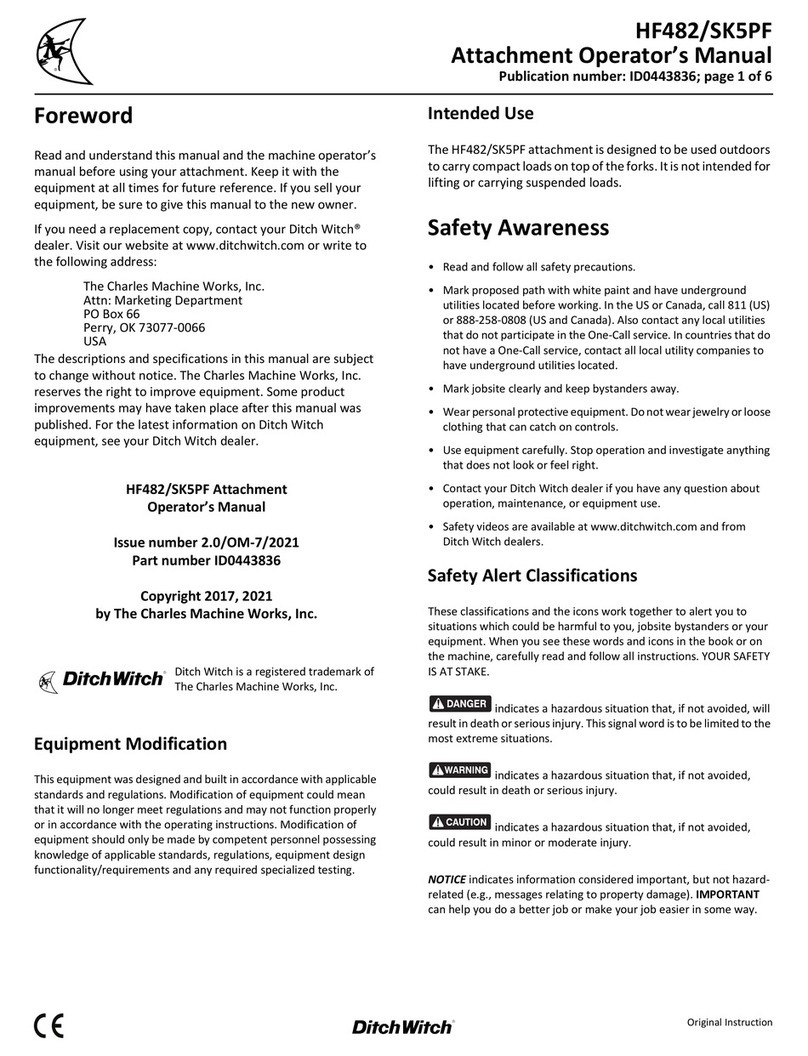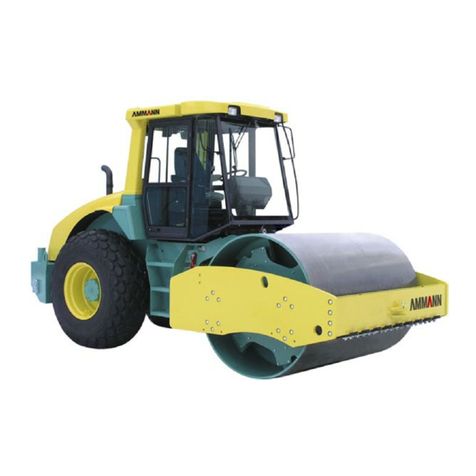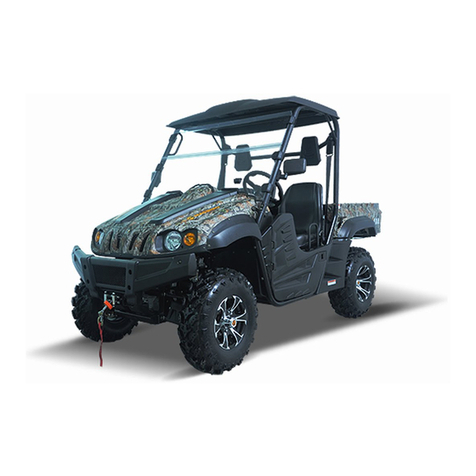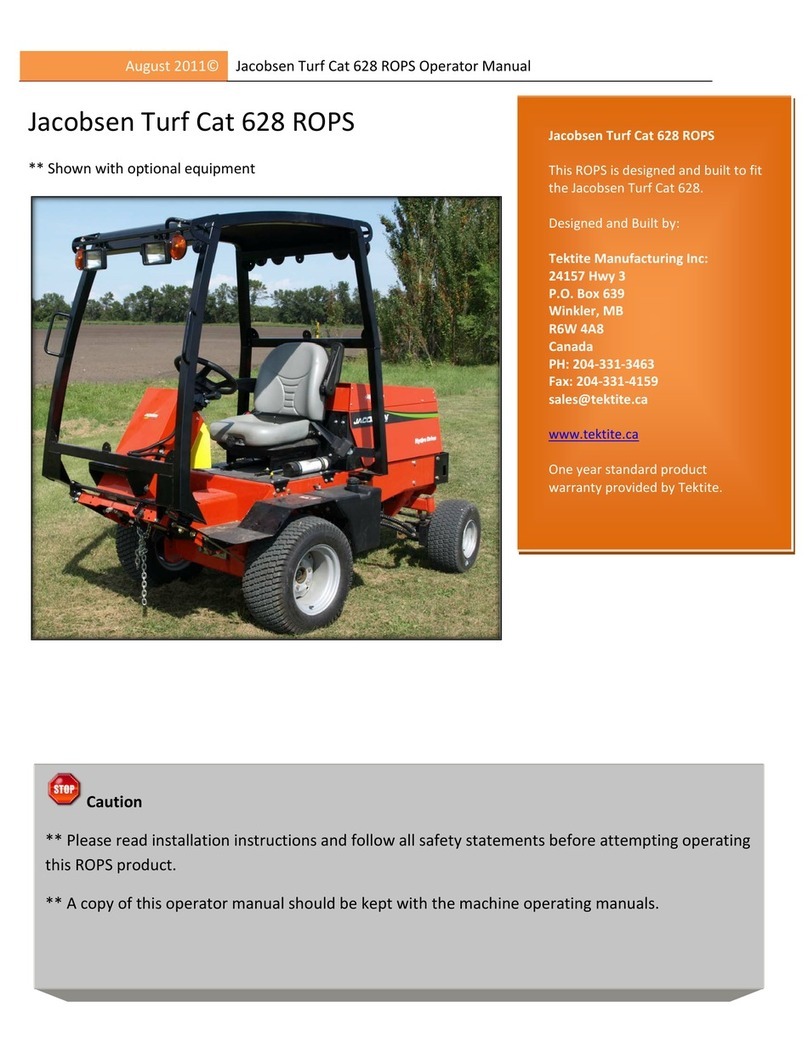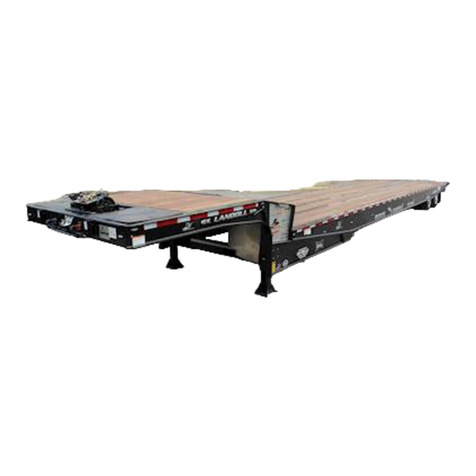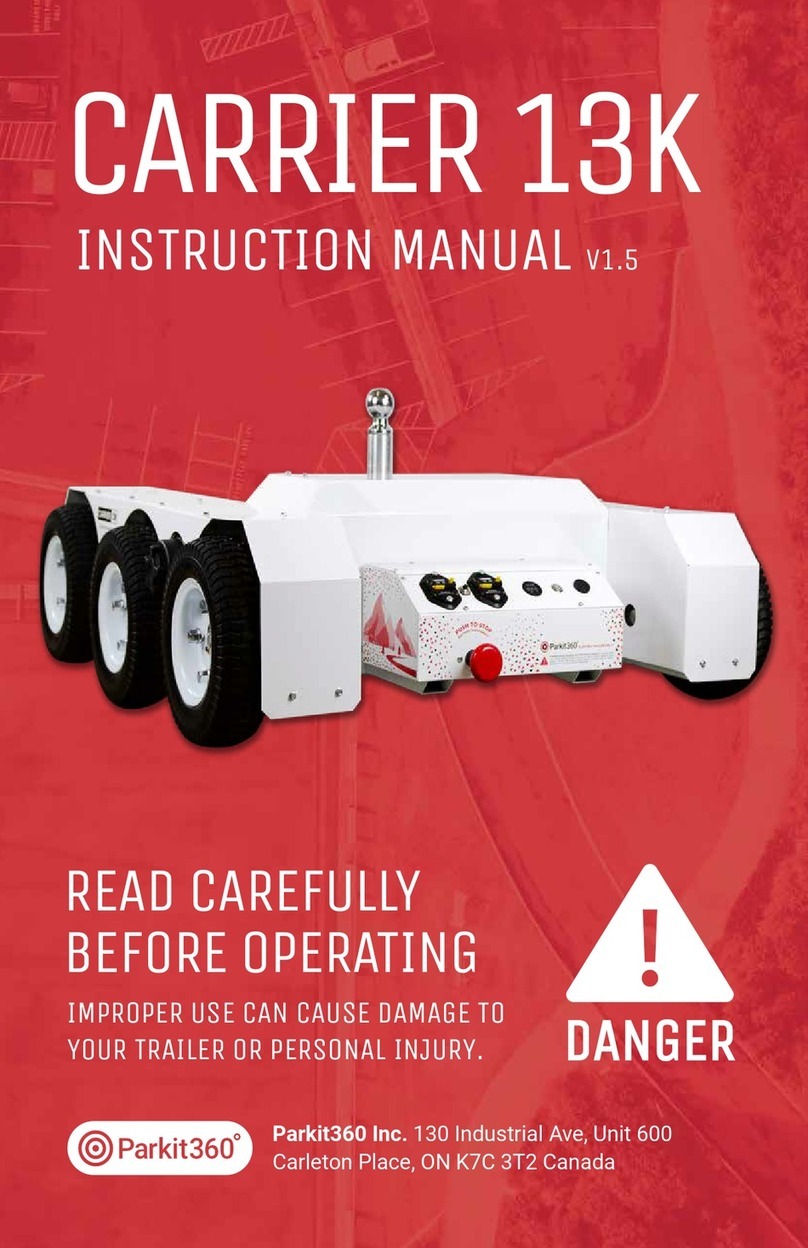Bomag BMP 8500 Manual

Operating instructions
Maintenance instructions
Original operating instructions
Catalogue No.
008 059 81 08/2011
BMP 8500
S/N 101 720 11 1930 >
Multi-purpose compactor
BSS0134R


Foreword
BOMAG 3BMP 8500
F oreword
BOMAG machines are products from the wide
range of BOMAG compaction equipment.
BOMAG’s vast experience in connection with
state-of-the-art production and testing meth-
ods, such as lifetime tests of all important
components and highest quality demands
guarantee maximum reliability of your ma-
chine.
This manual comprises:
lSafety regulations
lOperating instructions
lMaintenance instructions
lTrouble shooting
Using these instructions will
lhelp you to become familiar with the machine.
lavoid malfunctions caused by unprofessional
operation.
Compliance with the maintenance instructions will
lenhance the reliability of the machine on con-
struction sites,
lprolong the lifetime of the machine,
lreduce repair costs and downtimes.
BOMAG GmbH will not assume liability for the
function of the machine
lif it is handled in a way that does not comply
with the usual modes of use,
lif it is used for purposes other than the ones it
is intended for (see safety regulations).
No warranty claims can be lodged in case of dam-
age resulting from
loperating errors,
linsufficient maintenance and
lwrong fuels and lubricants.
Please note!
This manual was written for operators and mainte-
nance personnel on construction sites.
Always keep this manual close at hand, e.g. in the
tool compartment of the machine or in a specially
provided container. These operating and mainte-
nance instructions are part of the machine.
You should only operate the machine after you
have been instructed and in compliance with these
instructions.
Strictly observe the safety regulations.
Please observe also the guidelines of the Civil En-
gineering Liability Association ”Safety Rules for
the Operation of Road Rollers and Soil Compac-
tors” and all relevant accident prevention regula-
tions.
For your own personal safety you should only
use original spare parts from BOMAG.
In the course of technical development we re-
serve the right for technical modifications
without prior notification.
These operating and maintenance instructions are
also available in other languages.
Furthermore, the spare parts catalogue is availa-
ble from your BOMAG dealer against the serial
number of your machine.
Your BOMAG dealer will also supply you with in-
formation about the correct use of our machines in
soil and asphalt construction.
The above notes do not constitute an extension of
the warranty and liability conditions specified in the
general terms of business of BOMAG GmbH.
We wish you successful work with your BOMAG
machine.
BOMAG GmbH
Printed in Germany
Copyright by BOMAG
FCC Notice
1)Changes or modifications not expressly approved by the party
responsible for compliance could void the user's authority to operate
the equipment.
2)This equipment has been tested and found to comply with the limits
for a Class B digital device, pursuant to part 15 of the FCC Rules.
These limits are designed to provide reasonable protection against
harmful interference in a residential installation. This equipment
generates, uses and can radiate radio frequency energy and, if not
installed and used in accordance with the instructions, may cause
harmful interference to radio communications. However, there is no
guarantee that interference will not occur in a particular installation. If
this equipment does cause harmful interference to radio or television
reception, which can be determined
by turning the equipment off and on, the user is encouraged to try to
correct the interference by one or more of the following measures:
—Reorient or relocate the receiving antenna.
—Increase the separation between the equipment and receiver.
—Connect the equipment into an outlet on a circuit different from that
to which the receiver is connected.
—Consult the dealer or an experienced radio/TV technician for help.
3)This device complies with part 15 of the FCC Rules. Operation is
subject to the following two conditions: (1) This device may not cause
harmful interference, and (2) this device must accept any interference
received, including interference that may cause undesired operation.

Foreword
BOMAG4BMP 8500
Please fill in
. . . . . . . . . . . . . . . . . . . . . . . . . . . .
Machine type (Fig. 1)
. . . . . . . . . . . . . . . . . . . . . . . . . . . .
Serial-number (Fig. 1 and 2)
. . . . . . . . . . . . . . . . . . . . . . . . . . . .
Motor type (Fig. 3)
. . . . . . . . . . . . . . . . . . . . . . . . . . . .
Motor number (Fig. 3)
i
Note
Supplement the above data together with the com-
missioning protocol.
During commissioning our organisation will in-
struct you in the operation and maintenance of the
machine.
Please observe strictly the safety regulations and
all notes on risks and dangers!
Fig. 1
Fig. 2
Fig. 3

Table of Contents
BOMAG 5BMP 8500
Technical Data 7
Safety regulations 13
Indicators and Controls 23
3.1 General notes 26
3.2 Description of indicators and control elements 26
Operation 31
4.1 General 32
4.2 Tests before taking into operation 32
4.3 BOSS safety system 33
4.4 Starting the engine 34
4.5 Driving the machine (cable remote control) 36
4.6 Safety inspection for the cable remote control 39
4.7 Switching the vibration on and off 39
4.8 Shut down the engine 41
4.9 Shutting down the engine manually 42
4.10 Starting operation of the radio remote control 43
4.11 Replacing, recharging the radio remote control power pack 47
4.12 Safety inspection for the radio remote control 49
4.13 Switching off of the radio remote control in case of radio interferences 50
4.14 Switching ECO-mode on and off 50
4.15 Entering the machine type code 51
4.16 Teaching the BOSS safety system transponder 52
4.17 Assembling/removing the drum extension 53
4.18 Loading and transport 53
Maintenance 55
5.1 General notes on maintenance 56
5.2 Fuels and lubricants 57
5.3 Table of fuels and lubricants 60
5.4 Running-in instructions 61
5.5 Maintenance table 62
5.6 Check the engine oil level 65
5.7 Checking the hydraulic oil level 65
5.8 Checking the fuel level 66
5.9 Check the water separator 66
5.10 Checking the coolant level 67
5.11 Check the air intake hose 69
5.12 Changing engine oil and oil filter 69
5.13 Checking, tensioning, replacing the V-belt 71
5.14 Clean the cooling fins on engine and hydraulic oil cooler 72
5.15 Change the oil in the vibrator shaft housing 73
5.16 Checking the central screw of the drive hub 75

Table of Contents
BOMAG6BMP 8500
5.17 Draining the fuel tank sludge 77
5.18 Changing the fuel pre-cleaner, bleeding the fuel system 77
5.19 Battery service, checking the main battery switch 79
5.20 Check the rubber buffers 80
5.21 Checking, adjusting the valve clearance 81
5.22 Safety field measurement of the Boss safety system 82
5.23 Change hydraulic oil and filter 83
5.24 Change the coolant 84
5.25 Change the fuel lines 86
5.26 Checking the injection pressure 86
5.27 Checking the fuel injection pump 87
5.28 Checking the fuel injection timing 87
5.29 Check, clean, replace the combustion air filter 89
5.30 Adjust the scrapers 92
5.31 Tightening torques for screws with metric unified thread 92
5.32 Engine conservation 93
Trouble shooting 95
6.1 General notes 96
6.2 Engine problems 97
6.3 Problems with remote control Hetronic with spiral cable 99
6.4 Problems with radio remote control Hetronic in radio operation 102
6.5 Faults in BOSS safety system 104
6.6 Fault indicator 105
6.7 Fault code 106
6.8 Input codes for BLM control 119

BOMAG 7BMP 8500
1 Technical Data

Technical Data
BOMAG8BMP 8500
Dimensions in
mm (inches)
A D H K LS W W1
BMP 8500 1000
(39.4)
520
(20.5)
1275
(50.2)
222
(8.7)
1897
(74.7)
25
(1.0)
850
(33.5)
610
(24.2)
*BMP 8500
Weights
Operating weight (CECE) kg (lbs) 1595 (3516)
Basic weight kg 1585 (3494)
Mean axle load (CECE) kg 775 (1709)
Travel characteristics
Travel speed (1) forward/reverse km/h (mph) 1,3 (0.8)
Travel speed (2) forward/reverse km/h (mph) 2,5 (1.6)
Max. gradability without/with vibration (soil dependent) % 55/45
Drive
Engine manufacturer Kubota
Type D 1005
Cooling Water
Number of cylinders 3
Rated power ISO 9249 kW (hp) 14,5 (19.4)
Rated speed rpm 2600
Drive system hydrostatic
Driven drums front + rear
Brakes
Service brake hydrostatic
Parking brake mechanical

Technical Data
BOMAG 9BMP 8500
Steering
Type of steering Articulated joint
Steering operation hydrostatic
Vibration system
Vibrating drum front + rear
Drive system hydrostatic
Frequency Hz 42
Amplitude 1/2 mm (in) 1,12/0,56 (0.04/0.02)
Centrifugal force 1/2 kN (lbf) 72/36 (16186/8093)
Filling capacities
Fuel (diesel) l (gal us) 24 (6.3)
Hydraulic oil l (gal us) 17 (4.5)
Engine oil l (gal us) 4,7 (1.24)
Coolant l (gal us) 4,5 (1.19)
Vibration housing l (gal us) 2x 1,7 (2x 0.45)
Safety field system
Performance level PL c
Reach of the safety field infront of/behind the machine m (ft) > 1,20 (> 3,94)
Safety field control
Voltage V 8 ... 30
Current consumption at 12 V A 1.5
Protection class IP 55
Safety field frequency kHz 125
Operating temperature °C (°F) -20 ... +80 (-4 ... +176)
Storage temperature °C (°F) -40 ... +85 (-40 ... +185)
Transponder in remote control
Voltage (cable operation) V 9 ... 30
Voltage (battery operation) V 3.6
Transmitting frequency range MHz 868/916
Operating temperature °C (°F) -20 ... +80 (-4 ... +176)
Storage temperature °C (°F) -40 ... +85 (-40 ... +185)
Safety field antenna
Protection class IP 55
Operating temperature °C (°F) -20 ... +80 (-4 ... +176)
Storage temperature °C (°F) -40 ... +85 (-40 ... +185)
Radio remote control
Manufacturer HETRONIC
Transmitter
Frequency band F-band
*BMP 8500

Technical Data
BOMAG10 BMP 8500
Transmitting frequency range MHz 868 / 916
Number of channels 1
Reach, depending on environment m (ft) approx. 30 (98.4)
Current draw mA approx. 10
Weight kg (lbs) approx. 1.6 (3.5)
Receiver
Receiver frequency range MHz 868 / 916
Current draw mA approx. 10
Transmitter power pack
Voltage V 3.6
Capacity Ah 1.2
Battery charger
Operating voltage V (AC) 110/230
V (DC) 12 - 24
* The right for technical modifications remains reserved
*BMP 8500

Technical Data
BOMAG 11BMP 8500
The following noise and vibration data acc. to
- EC Machine Regulation edition 2006/42/EC
- the noise regulation 2000/14/EG, noise protection guideline 2003/10/EC
- Vibration Protection Regulation 2002/44/EC
were determined during conditions typical for this type of equipment and by application of harmo-
nized standards.
During operation these values may vary because of the existing operating conditions.
Noise value
Sound pressure level on the place of the operator:
LpA = 85 dB(A), determined acc. to ISO 11204 and EN 500
Guaranteed sound power level:
LWA = 103 dB(A), determined acc. to ISO 3744 and EN 500
!Danger
Wear your personal noise protection means (ear defenders) before starting operation.

Technical Data
BOMAG12 BMP 8500

BOMAG 13BMP 8500
2 Safety regulations

Safety regulations
BOMAG14 BMP 8500
General
This BOMAG machine has been built in com-
pliance with the latest technical standard and
complies with the applicable regulations and
technical rules. However, dangers for persons
and property may arise from this machine, if:
lit is used for purposes other than the ones it is
intended for,
lit is operated by untrained personnel,
lit is changed or converted in an unprofessional
way,
lthe safety instructions are not observed.
Each person involved in the operation, mainte-
nance and repair of the machine must there-
fore read and comply with these safety
regulations. If necessary, this must be con-
firmed by obtaining the signature of the cus-
tomer.
Furthermore, the following obviously also applies:
lapplicable accident prevention instructions,
lgenerally accepted safety and road traffic reg-
ulations,
lcountry specific safety regulations. It is the
duty of the operator to be acquainted with
these instructions and to apply these accord-
ingly. This applies also for local regulations
concerning different types of handling work.
Should the recommendations in these instruc-
tions be different from the regulations valid in
your country, you must comply with the safety
regulations valid in your country.
Intended use
This machine must only be used for:
lCompaction of cohesive soils in trench con-
struction
lConstruction backfills
lEarthwork in sewer and pipeline construction
lEarthwork in railway and dam construction
lEarthwork in sanitary landfill construction
lSubbase and foundation work
The place of the operator is behind the machine.
When operating the machine from the opposite
side, actuation of travel controls will cause ma-
chine movements, which are not in compliance
with the movement of the control elements.
Fig. 4
lThe remote control must be carried in front of
the body, as intended (Fig. 4).
Unintended use
Danger may arise from the machine if it is used for
purposes other than the one it is intended for.
Any danger caused by unintended use is the sole
responsibility of the customer or driver/operator,
the manufacturer cannot be made liable.
Examples for unintended use are:
lwork with vibration on hard concrete, cured bi-
tumen layers or extremely frozen ground
ldriving on unstable subbases or insufficient
grip or too small contact area (danger of tip-
ping over)
lusing the machine on for towing
loperating the machine without visual contact
The transport of persons is prohibited.
Starting and operation of the machine in explosive
environments and in underground mining is pro-
hibited.
Remaining dangers, remaining risks
Despite careful work and compliance with stand-
ards and regulations it cannot be ruled out that fur-
ther dangers may arise when working with and
handling the machine.
Both the machine as well as all other system com-
ponents comply with the currently valid safety reg-
ulations. Nevertheless, remaining risks cannot be
ruled out completely, even when using the ma-

Safety regulations
BOMAG 15BMP 8500
chine for the purpose it is intended for and follow-
ing all information given in the operating
instructions.
A remaining risk can also not be excluded beyond
the actual danger zone of the machine. Persons
remaining in this area must pay particular attention
to the machine, so that they can react immediately
in case of a possible malfunction, an incident or
failure etc.
All persons remaining ion the area of the machine
must be informed about the dangers that arise
from the operation of the machine.
Regular safety inspections
Have the machine inspected by an expert (capa-
ble person) as required for the conditiosn the ma-
chine is working under, but at least once every
year.
Who is allowed to operate the ma-
chine?
Only trained, instructed and authorized persons of
at least 18 years of age are permitted to drive and
operate this machine. For operation of the ma-
chine the responsibilities must be clearly specified
and complied with.
Persons under the influence of alcohol, medicine
or drugs are not allowed to operate, service or re-
pair the machine.
Maintenance and repair work requires specific
knowledge and must therefore only be performed
by trained specialists.
Conversions and alterations to the ma-
chine
Unauthorized conversions to the machine are pro-
hibited for safety reasons.
Original parts and accessories have been special-
ly designed for this machine. We wish to make ex-
pressly clear that we have not tested or authorized
any original parts or special equipment not sup-
plied by us. The installation and/or use of such
products can impair the active and/or passive driv-
ing safety. The manufacturer expressly excludes
any liability for damage resulting from the use of
non-original parts or accessories.
Damage, deficiencies, misuse of safety
installations
Machines which are not safe to operate or in traffic
must be immediately taken out of service and shall
not be used, until these deficiencies have been
properly rectified.
Safety installations and switches must neither be
removed nor must they be made ineffective.
Safety notes in the operating and main-
tenance instructions:
!Danger
Sections marked like this point out possible
dangers for persons.
!
Caution
Sections marked like this point out possible
dangers for the machine or for parts of the ma-
chine.
i
Note
Sections marked like this provide technical infor-
mation concerning the optimal economical use of
the machine.
Environment
Sections marked like this highlight activities
for the safe and environmental disposal of fu-
els and lubricants as well as replaced parts.
Observe all environment protection regula-
tions.
Loading the machine
Use only stable loading ramps of sufficient load
bearing capacity. The ramp inclination must be
less than the gradability of the machine.
Make sure that persons are not endangered by the
machine tipping or sliding off.
Always engage the articulation lock before load-
ing, lifting and transporting the machine.
Use only safe lifting gear of sufficient load bearing
capacity Minimum lifting capacity of lifting gear:
see operating weight in chapter "Technical Data".
For lifting the machine attach the lifting gear only
to the lifting eye provided for this purpose.

Safety regulations
BOMAG16 BMP 8500
Check lifting eye for damage before use. Do not
use a damaged or in any other way impaired lifting
eye.
The machine must not swing about when being lift-
ed.
Do not step or stand under suspended loads.
Lash the machine down, so that it is secured
against rolling, sliding and turning over.
Check the fastening of the central lifting hook be-
fore each use.
Recovering/towing the machine
The machine can be recovered by lifting it out of
the danger area.
Recovering/towing the machine
The machine can be recovered by lifting it out of
the danger area.
!Danger
Life hazard!
Lift the machine only with suitable lifting gear.
Weight: see chapter "Technical Data".
Starting the machine
Before starting
When operating several machines with radio re-
mote controls the system numbers of the individu-
al control units must be checked.
Use only machines which are serviced at regular
intervals.
Become acquainted with the equipment, the con-
trol elements, the working principle of the machine
and the working area.
Wear your personal protective outfit (hard hat,
safety boots, etc.).
Before starting the machine check whether:
lpersons or obstructions are near the machine
lthe machine shows any obvious faults
lall guards and safety elements are in place
lbrakes, control elements and horn are working
lengine hood is closed and locked
Do not start the machine with defective gauges,
control lights or control elements.
Do not take any loose objects with you or fasten
them to the machine.
Starting
For starting set all control levers to 'neutral posi-
tion'.
Do not use any starting aids like start pilot or ether.
After starting check all gauges and control lights.
Starting with jump wires
Connect positive with positive and negative with
negative (ground cable) – always connect the
ground strap last and disconnect it first! A wrong
connection will cause severe damage in the elec-
tric system.
Do not start the engine by shorting the electric ter-
minals on the starter motor, because the machine
may start to drive immediately.
Do not use any starting aids like start pilot or ether.
Starting and operation of the machine is
closed rooms and trenches
Exhaust gases are highly dangerous! Always en-
sure an adequate supply of fresh air when starting
and operating in closed rooms and trenches!
Driving the machine
Persons in the danger area
Before taking up work, also after breaks, you
should always convince yourself that the danger
zone is free of persons or obstructions, especially
when driving in reverse.
Give warning signals, if necessary. Stop work im-
mediately if persons remain in the danger zone,
despite the warning.
Driving
Do not use the machine to transport persons.
In case of unusual noises and development of
smoke perform trouble shooting and have the fault
corrected.
Always keep a sufficient distance to excavation
walls and embankments and do not use working
methods that could impair the stability of the ma-
chine.
Do not work with vibration on hard concrete, cured
bitumen layers or extremely frozen ground.

Safety regulations
BOMAG 17BMP 8500
Driving on inclinations and slopes
Fig. 5
Do not drive on gradients exceeding the maximum
gradability of the machine.
On slopes drive extremely careful and always di-
rectly up or down the slope. Change to a lower
gear before starting to drive.
Wet and loose soils considerably reduce the
ground adhesion of the machine on inclinations
and slopes. Higher risk of accident!
Inclination
Fig. 6
The tipping angle was measured in static condition
on level, hard ground with the machine stopped,
no steering and without vibration.
With loose soil, acceleration/deceleration, running
vibration, steering or attached accessoriies the tip-
ping angle may be considerably lower.
Driving across slopes should therefore be strictly
avoided, because of the high risk of tipping over
and the related risk of severe or even fatal acci-
dents.
You should therefore always drive straight up or
down a slope.
Behaviour in traffic
Match the speed to the working conditions.
Always give way to loaded transport vehicles.
Keep away from edges and embankments.
Checking the effect of vibration
When compacting with vibration you must check
the effect on nearby buildings and underground
supply lines (gas, water, sewage, electric power),
if necessary stop compaction work with vibration.
Do not activate the vibration on hard (frozen, con-
crete) ground. Danger of bearing damage!
Parking the machine
Park the machine on horizontal, level, firm ground.
Before leaving the machine:
lshut the engine down, pull the ignition key off
lsecure the machine against unintended use.
lPull off the main battery switch.
Mark machines, which could be in the way, with a
clearly visible sign.
Refuelling
Do not inhale any fuel fumes.
Refuel only with the engine shut down.
Do not refuel in closed rooms.
No open fire, do not smoke.
Monitor the entire refuelling process.
Do not spill any fuel. Catch running out fuel, do not
let it seep into the ground.
Wipe off spilled fuel. Keep dirt and water away
from the fuel.
A leaking fuel tank can cause an explosion. En-
sure tight fit of the fuel tank cover, if necessary re-
place immediately.
Fire protection measures
Familiarise yourself with the location and the oper-
ation of fire fighting equipment. Observe all fire re-
porting and fire fighting possibilities.

Safety regulations
BOMAG18 BMP 8500
Maintenance work
Comply with the maintenance work described in
the operating and maintenance instructions, in-
cluding the information concerning the replace-
ment of parts.
Maintenance work must only be performed by
qualified and authorized persons.
Keep unauthorized persons away from the ma-
chine.
Do not perform maintenance work while the ma-
chine is driving or the engine is running.
Park the machine on horizontal, level, firm ground.
Pull off the ignition key and switch off the main bat-
tery switch.
Work on hydraulic lines
Relieve hydraulic pressures before working on hy-
draulic lines. Hydraulic oil escaping under pres-
sure can penetrate the skin and cause severe
injury. When being injured by hydraulic oil consult
a medical doctor immediately, as otherwise this
may cause severe infections.
Do not step in front of or behind the drums when
performing adjustment work in the hydraulic sys-
tem.
Do not change the setting of pressure relief valves.
Drain the hydraulic oil at operating temperature –
danger of scalding!
Catch running out hydraulic oil and dispose of en-
vironmentally.
Always catch and dispose of hydraulic oils sepa-
rately.
Do not start the engine after draining the hydraulic
oil.
Once all work is completed (with the system still
depressurized!) check all connections and fittings
for leaks.
Changing hydraulic hoses
Hydraulic hoses must be visually inspected at reg-
ular intervals.
Hydraulic hoses must be immediately replaced if:
lthe outer layer is damaged down to the inlay
(e.g. chafing, cuts, cracks)
lthe outer layer is brittle (formation of cracks in
the hose material)
lthe hose shows deformations in pressurized
and depressurized condition, which do not
comply with the genuine shape of the hydrau-
lic hose
lthe hose shows deformations in bends, e.g.
squeezing, buckling, layer separation, forma-
tion of blisters
lparts of the hose are leaking.
lhoses are not correctly installed.
lthe hydraulic hose has separated from the fit-
ting
lthe fitting shows corrosion that impairs both
function and strength.
lhoses are mixed up by mistake.
lfittings are damaged or deformed, whereby
the function and strength of the hose/hose
connection is impaired.
Only genuine BOMAG replacement hydraulic hos-
es ensure that the correct hose type (pressure
range) is used at the right location.
Working on the engine
Shut the engine down before opening the engine
hood.
Drain the engine oil at operating temperature –
danger of scalding!
Wipe off spilled oil, catch running out oil and dis-
pose of environmentally.
Store used filters and other oil contaminated ma-
terials in a separate, specially marked container
and dispose of environmentally.
Do not leave any tools or other objects, that could
cause damage, in the engine compartment.
Working on electric parts of the machine
!
Caution
Disconnect the minus pole first and the plus
pole after.
Connect the battery in reverse order. Connect
the plus pole first and the minus pole after.
Before starting to work on electric parts of the ma-
chine disconnect the battery and cover it with insu-
lating material.
Do not use fuses with higher ampere ratings and
do not repair fuses with a piece of wire. Fire haz-
ard!

Safety regulations
BOMAG 19BMP 8500
Working on the battery
When working on the battery do not smoke, do not
use open fire!
Do not let acid come in contact with hands or
clothes! When injured by acid flush off with clear
water and seek medical advice.
Metal objects (e.g. tools, rings, watch straps) must
not come in contact with the battery poles – dan-
ger of short circuit and burning!
When recharging non-serviceable batteries re-
move all plugs, to avoid the accumulation of explo-
sive gases.
Observe the applicable instructions when starting
with an auxiliary battery.
Dispose of old batteries according to regulations.
Switch off the charging current before removing
the charging clamps.
Ensure sufficient ventilation, especially if the bat-
tery is to be charged in a closed room.
Working on the fuel system
Do not inhale any fuel fumes.
Avoid open fire, do not smoke, do not spill any fuel.
Catch running out fuel, do not let it seep into the
ground and dispose off environmentally.
Cleaning work
Do not perform cleaning work while the motor is
running.
Do not use gasoline or other easily inflammable
substances for cleaning.
When cleaning with steam cleaning equipment do
not subject electrical parts and insulation material
to the direct jet of water, or cover it beforehand.
lDo not guide the water jet into the exhaust and
into the air filter.
After maintenance work
After all maintenance work is completed reinstall
all guards and safety installations.
Repair
Mark a defective machine by attaching a warning
tag to the dashboard.
Before starting electric welding work on the ma-
chine, all electrical components must be discon-
nected from the power supply.
Repair work must only be performed by qualified
and authorized persons. Use our repair instruc-
tions for this work.
Exhaust gases are highly dangerous! Always en-
sure an adequate supply of fresh air when starting
in closed rooms!
Test
The safety of compaction equipment must be
checked by a specialist as required in dependence
on the application and the operating conditions,
however at least once every year.
Radio remote control
The machine must only be operated within the
field of vision of the operator.
The radio remote control must only be used by
trained and authorized persons.
The safety features incorporated in the radio re-
mote control must be checked at regular intervals.
A defective radio remote control must no longer be
used.
In case of radio interferences watch the fault code
display and switch to cable remote control, if nec-
essary
The machine will stop when the reach of the radio
remote control is exceeded.
In case of defects the radio remote control must be
immediately taken out of service. The transmitter
must be switched off via the emergency stop func-
tion. The connecting cable must be disconnected
from the machine related socket on the receiver.
The radio remote control must only be repaired by
the manufacturer or specialists authorized by the
manufacturer.
When working on plug connections the machine
battery must be disconnected or the connecting
cable of the receiver pulled off.
All work related with the initial installation of a sys-
tem or with repair work must only be performed by
qualified personnel.
The person performing the work is fully liable for
professional execution of repair and maintenance
work in compliance with the regulations of the
manufacturer.
Warranty on spare parts can only be granted if
these parts were installed in compliance with our
regulations and instructions and by personnel au-

Safety regulations
BOMAG20 BMP 8500
thorized by us. We will not assume liability for
changes and modifications not performed by us.
Information and safety stickers/decals
on the machine
Keep safety stickers in good and legible condition
(see parts manual) and comply with their meaning.
Replace damaged and illegible stickers/decals.
Table of contents
Popular Utility Vehicle manuals by other brands
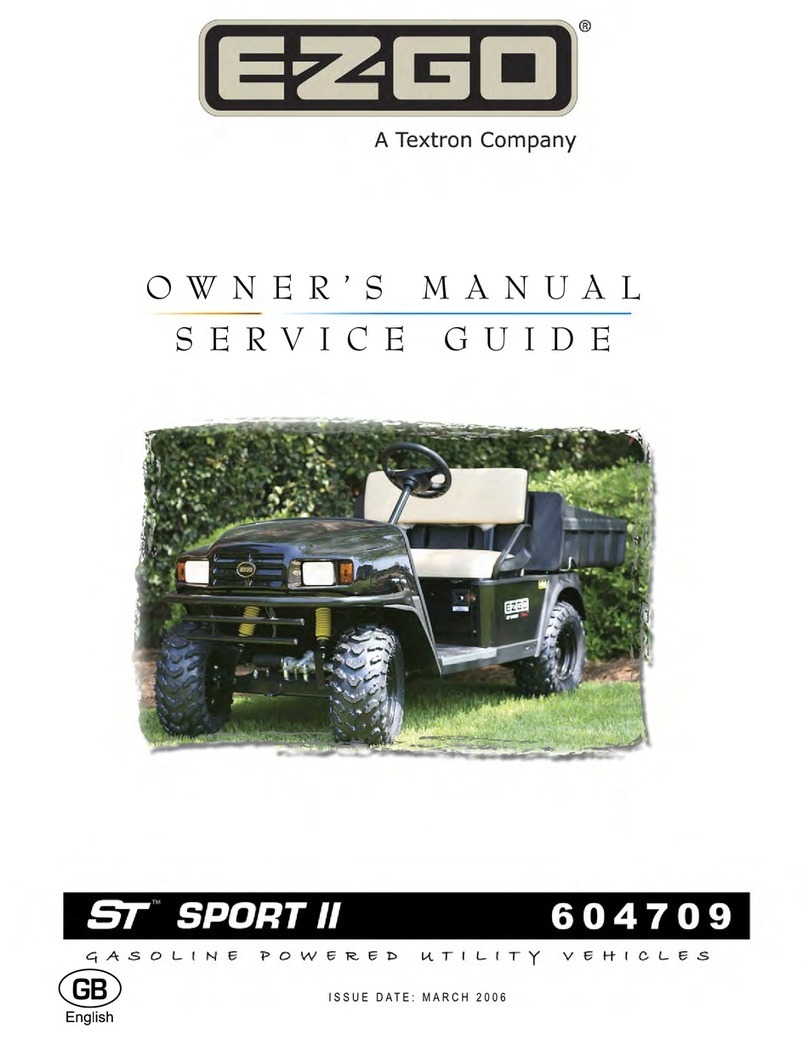
Textron
Textron EZGO owner's manual
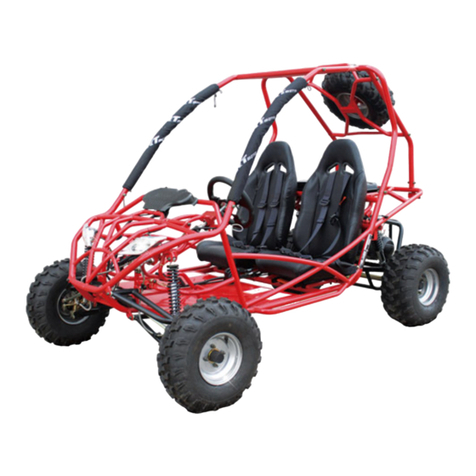
Dongfang Motor
Dongfang Motor DF150GK Series Assembly instruction
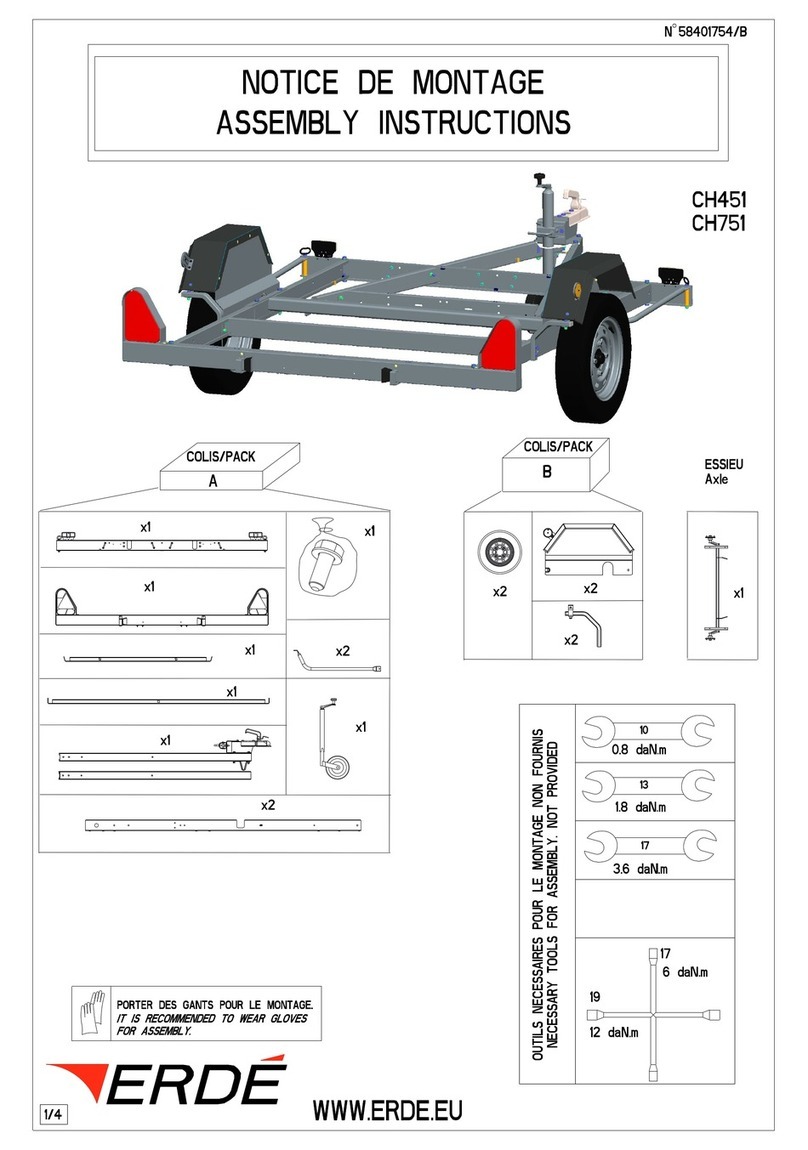
Erde
Erde CH451 Assembly instructions
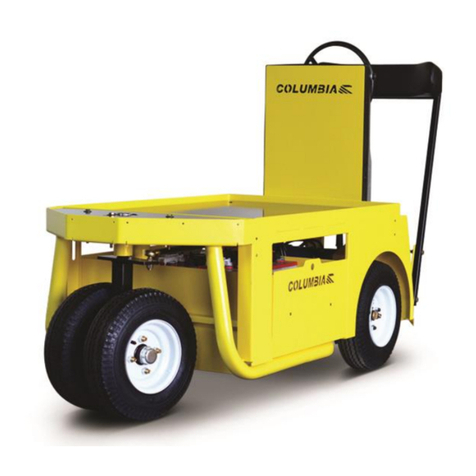
Columbia
Columbia Stockchaser IS12 2017 Owner's and operator's manual
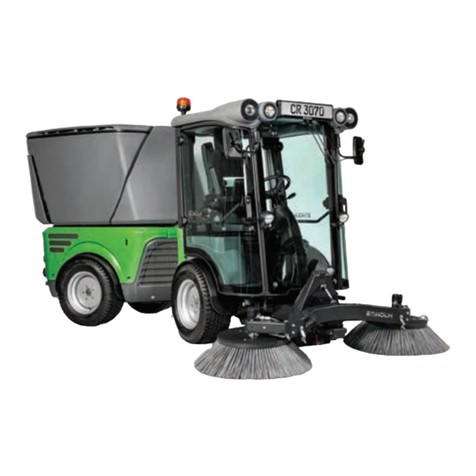
Egholm
Egholm City Ranger 3070 Operator's manual
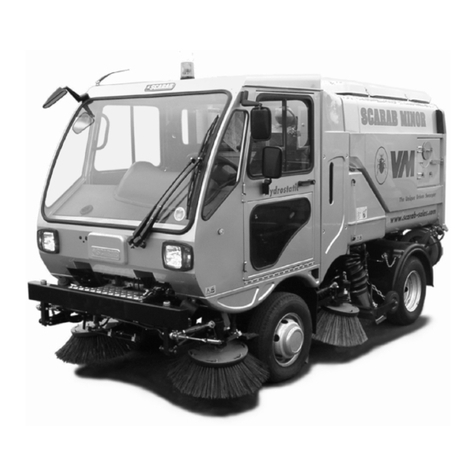
Scarab
Scarab Minor VM Hydrostatic Operator's manual

